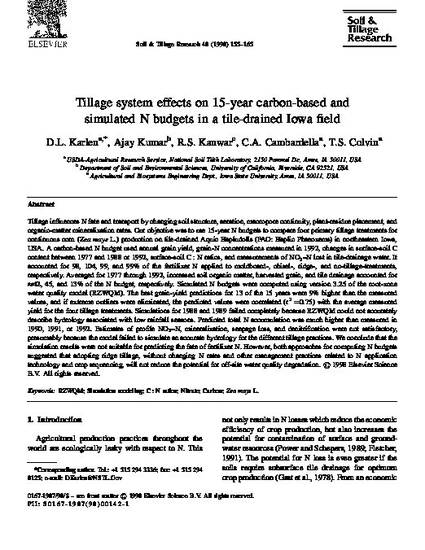
Tillage influences N fate and transport by changing soil structure, aeration, macropore continuity, plant-residue placement, and organic-matter mineralization rates. Our objective was to use 15-year N budgets to compare four primary tillage treatments for continuous corn (Zea mays L.) production on tile-drained Aquic Hapludolls (FAO: Haplic Phaeozems) in northeastern Iowa, USA. A carbon-based N budget used annual grain yield, grain-N concentrations measured in 1992, changes in surface-soil C content between 1977 and 1988 or 1992, surface-soil C : N ratios, and measurements of NO3–N lost in tile-drainage water. It accounted for 98, 104, 99, and 99% of the fertilizer N applied to moldboard-, chisel-, ridge-, and no-tillage-treatments, respectively. Averaged for 1977 through 1992, increased soil organic matter, harvested grain, and tile drainage accounted for ≈42, 45, and 13% of the N budget, respectively. Simulated N budgets were computed using version 3.25 of the root-zone water quality model (RZWQM). The best grain-yield predictions for 13 of the 15 years were 9% higher than the measured values, and if extreme outliers were eliminated, the predicted values were correlated (r2 =0.75) with the average measured yield for the four tillage treatments. Simulations for 1988 and 1989 failed completely because RZWQM could not accurately describe hydrology associated with low rainfall seasons. Predicted total N accumulation was much higher than measured in 1990, 1991, or 1992. Estimates of profile NO3–N, mineralization, seepage loss, and denitrification were not satisfactory, presumably because the model failed to simulate an accurate hydrology for the different tillage practices. We conclude that the simulation results were not suitable for predicting the fate of fertilizer N. However, both approaches for computing N budgets suggested that adopting ridge tillage, without changing N rates and other management practices related to N application technology and crop sequencing, will not reduce the potential for off-site water quality degradation.
Available at: http://works.bepress.com/douglas_karlen/7/

This article is from Soil and Tillage Research 48 (1998): 155–165, doi:10.1016/S0167-1987(98)00142-1.